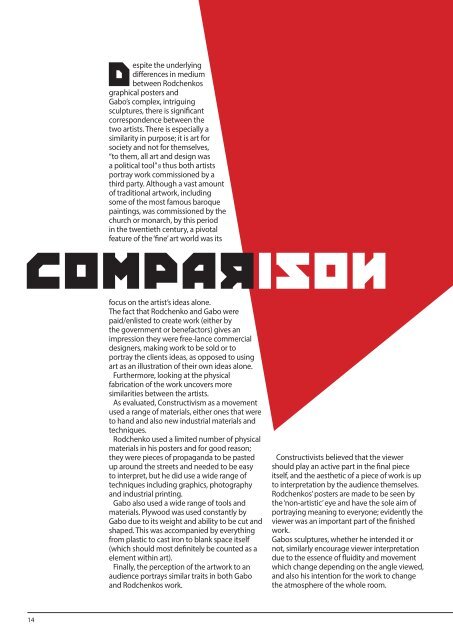Constructivist Written Study
Written
Written
You also want an ePaper? Increase the reach of your titles
YUMPU automatically turns print PDFs into web optimized ePapers that Google loves.
Despite the underlying<br />
differences in medium<br />
between Rodchenkos<br />
graphical posters and<br />
Gabo’s complex, intriguing<br />
sculptures, there is significant<br />
correspondence between the<br />
two artists. There is especially a<br />
similarity in purpose; it is art for<br />
society and not for themselves,<br />
“to them, all art and design was<br />
a political tool” 8 thus both artists<br />
portray work commissioned by a<br />
third party. Although a vast amount<br />
of traditional artwork, including<br />
some of the most famous baroque<br />
paintings, was commissioned by the<br />
church or monarch, by this period<br />
in the twentieth century, a pivotal<br />
feature of the ‘fine’ art world was its<br />
COMPARISON<br />
focus on the artist’s ideas alone.<br />
The fact that Rodchenko and Gabo were<br />
paid/enlisted to create work (either by<br />
the government or benefactors) gives an<br />
impression they were free-lance commercial<br />
designers, making work to be sold or to<br />
portray the clients ideas, as opposed to using<br />
art as an illustration of their own ideas alone.<br />
Furthermore, looking at the physical<br />
fabrication of the work uncovers more<br />
similarities between the artists.<br />
As evaluated, Constructivism as a movement<br />
used a range of materials, either ones that were<br />
to hand and also new industrial materials and<br />
techniques.<br />
Rodchenko used a limited number of physical<br />
materials in his posters and for good reason;<br />
they were pieces of propaganda to be pasted<br />
up around the streets and needed to be easy<br />
to interpret, but he did use a wide range of<br />
techniques including graphics, photography<br />
and industrial printing.<br />
Gabo also used a wide range of tools and<br />
materials. Plywood was used constantly by<br />
Gabo due to its weight and ability to be cut and<br />
shaped. This was accompanied by everything<br />
from plastic to cast iron to blank space itself<br />
(which should most definitely be counted as a<br />
element within art).<br />
Finally, the perception of the artwork to an<br />
audience portrays similar traits in both Gabo<br />
and Rodchenkos work.<br />
<strong>Constructivist</strong>s believed that the viewer<br />
should play an active part in the final piece<br />
itself, and the aesthetic of a piece of work is up<br />
to interpretation by the audience themselves.<br />
Rodchenkos’ posters are made to be seen by<br />
the ‘non-artistic’ eye and have the sole aim of<br />
portraying meaning to everyone; evidently the<br />
viewer was an important part of the finished<br />
work.<br />
Gabos sculptures, whether he intended it or<br />
not, similarly encourage viewer interpretation<br />
due to the essence of fluidity and movement<br />
which change depending on the angle viewed,<br />
and also his intention for the work to change<br />
the atmosphere of the whole room.<br />
14


